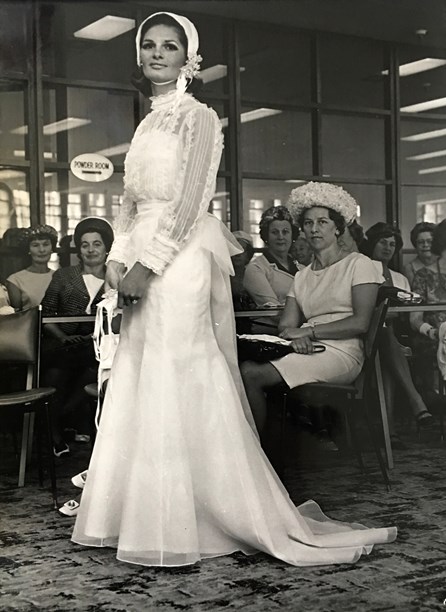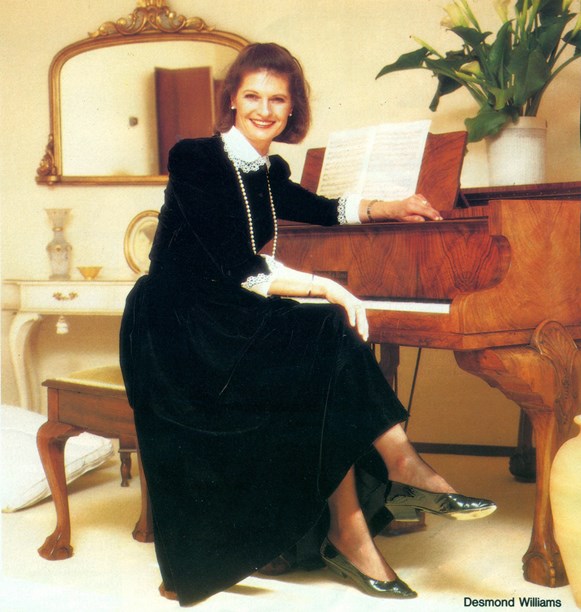Stories
Michal McKay

As the daughter of renowned fashion arbiter Paddy Walker, it should be no surprise that Michal McKay became a follower of fashion at a very young age. Photographed as mother and daughter by 'the' UK fashion bible L'Officiel (an English version of the French original) when she was five, she took to the catwalk in many a parade, first at her mother's side until ultimately she walked in the grand Milne & Choyce productions for which Paddy had gained a national reputation.
At the age of 14 Michal announced to Bernard Leser, a good friend of her mother's, that she wanted to be "a fashion editor". Bernie (as he was affectionally known) was just beginning his own illustrious career at the helm of Vogue publications in Australia. To his credit, he did not burst into laughter at the sight of a rather ungainly child, dressed in school uniform, having such aspirations. And during his own career trajectory from Australia to London to New York (Bernard Leser was the President of Conde Nast in the United States), he became Michal's mentor and guide throughout her career. Often they resided in the same cities of London, Sydney and New York, sometimes as work colleagues. They had a long friendship, which Michal openly acknowledges as being the pivot point in masterminding her own career.
During her teen years, Michal's fascination for fashion was equalled by a love of words and upon leaving school she joined the New Zealand Herald as a cadet reporter. It was the foundation of a broad-ranging and eclectic career - as both an internationally distinguished writer and editor, and as a businesswoman specialising in the area of lifestyle.
Michal’s next role, in 1964, was fashion and beauty editor of Vogue New Zealand, replacing Marie Stuttard who had been appointed fashion editor in 1961. Bernard Leser, who was its publisher at the time, introduced Michal to the editor of both the New Zealand and Australian Vogue, Sheila Scotter. Sheila interviewed Michal in London, where she was spending the mandatory OE, and offered her the role, with the proviso that she complete a three month training course in the London Vogue offices. She was to be schooled in the fashion, art and beauty departments. In Sheila's view, Michal needed to be "Voguerised".
The doors were opened to the international fashion stars of photography - Helmut Newton, Norman Parkinson and the 'terrible trio' - David Bailey, Terence Donovan and Brian Duffy - wild boys from the working class who behind the lens were making their definitive mark on fashion. Michal worked with Jean Shrimpton, Celia Hammond, Sue Murray, Jill Kennington, Marie Helvin, Patti Boyd and other top models of the era. Her mentors in the fashion room were Sheila Wetton, Helen Robinson and Claire Rendelsham, and her colleagues were Anna Harvey, Sandy Boler, Marit Allen and Liz Tilberis. With designers Courreges, Mary Quant, Yves St Laurent and Barbara Hulanicki of Biba the influencers, this was an incomparable line-up of everybody who meant anything in fashion during the 60s.
As the only editorial representative of the magazine in New Zealand (it was produced and printed in Australia) she flung herself into the Kiwi fashion scene with zeal. Despite her tender years (she was just 21), she developed strong partnerships with manufacturers and designers; guiding, cajoling and influencing the fashion scene. She made lifelong friendships with New Zealand fashion photographers Warren Scott, Bill Double, Barry McKinley, Michael Gillies and Desmond Williams.

Michal modelling a wedding dress by Babs Radon in a show held at 246 on Queen Street in February 1968. Image © Barbara Herrick.
By 1968, Vogue New Zealand had run its course and Michal had married, moved to London and been appointed fashion and beauty editor for the iconic British publication, Good Housekeeping. Her editor was one of the top names of the glossy magazine establishment, Laurie Purden and GH, as it was known, was the highest selling monthly glossy in the UK. "I am incredibly fortunate to have had the very best as my bosses; people who were at the peak of their careers and were willing to coach their staff into achieving the excellence they demanded of themselves and others."
"Going to the Prêt in Paris and the London ready-to-wear shows was de rigueur and often accompanying me in the cab from the office would be Jennifer Hocking and Anna Wintour both of whom worked on Harpers at the time." Michal went on to become an associate editor at Good Housekeeping.
She returned to Australia when her marriage ended, becoming Australian Vogue's associate editor, responsible for Fashion and Beauty. Here she worked with the luminaries like Patrick Russell, Dieter Muller, Bob Watson and Greg Barrett creating memorable fashion and beauty pages which she recalls her mentor Bernie regarded as "some of the best ever produced".

Michal McKay wears a black velvet dress with white collar and cuffs that she designed herself and had made up by her dressmaker. Photo by Desmond Williams, © Fashion Quarterly, 1986.
Michal was beckoned to the "other side" by her interest in the creation of fashion. She took on a role as design director for top fashion designers, Trent Nathan, Norma Tullo and Carla Zampatti, garnering multiple awards during this time.
Communications, brand development and marketing continued to vie for her attention with subsequent tenures at Country Road, Estee Lauder, Sportsgirl and Turkish luxury goods retailer, Beymen. These appointments were interspersed with roles in fashion media such as fashion and beauty editor at the Australian Women’s Weekly under the leadership of respected editor, Ita Buttrose, fashion director and then editor of Mode magazine, editor of New Zealand Women's Weekly, another stint at GH as deputy editor and then editor of Vogue Singapore.
In 2005 Fairfax approached Michal offering editorship of two of New Zealand’s leading magazines, New Zealand House & Garden and its offshoot On Holiday. Michal had been away from New Zealand for 18 years and the call to come home was strong. She returned accompanied by a 12-metre container of luggage and furniture. The role of editorial director of Fairfax Magazines, including Cuisine, quickly followed.
Having been raised with her mother Paddy's concept of fashion as "affecting everything", Michal had clearly come to much the same opinion. While with Beymen in Istanbul, she had advised their customers: "Fashion does not just mean clothes. It includes everything that stimulates the senses such as art, music, theatre, literature, food, interior architecture, architecture, and garden care." Which was exactly the mix that the new Fairfax editorship included.
After five years with Fairfax, she set up her own company MAIKI Ltd. Known as Style Counsel, she ran a creative communications consultancy, providing services in the areas of journalism, travel and tourism, branding concepts for fashion, homewares and beauty products, as well as the production of special events.
During her years helming her consultancy, she has also been a senior account director for Cook Islands Tourism, development consultant with the Royal New Zealand Ballet, columnist for Viva, coordinator of the Auckland Museum’s Wonderland exhibition, and a trustee of the New Zealand Fashion Museum.
She was, until her move to Havelock North in 2015, on the Board of Look Good Feel Better and still participates as a committee member for World Child Cancer Charity Trust and the Hawkes Bay Decorative and Fine Arts.
Michal's involvement in the world of fashion has covered the gamut from commentary to creation. At a function in 2015, she appeared in a pure white shift, stunningly simple but cleverly constructed. Someone asked her who designed it. She replied quietly - "I did".
Text by Max Cryer. Banner image © Te Papa Tongarewa Museum of New Zealand.
Last published January 2017.